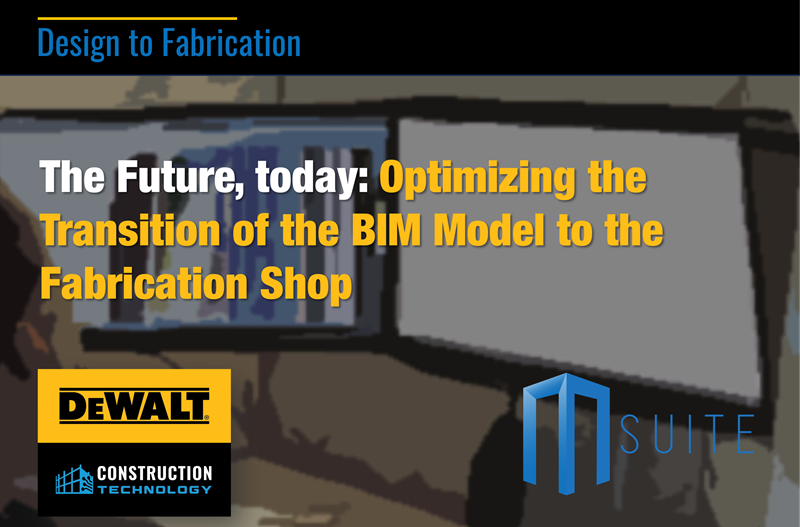In the dynamic realm of construction, the seamless integration of technology can reshape how projects are conceived and executed. The Virtual Design and Construction (VDC) BIM model is a central hub of project information, notably encapsulated in the Building Information Model (BIM). However, the challenge arises when traditional fabrication processes need help to keep pace with the rapid advancements in VDC technology. This article investigates the transformative solution facilitating the transition of the BIM model to the fabrication shop, focusing on the innovative contributions of platforms like MSUITE.
The BIM Model’s Crucial Role:
The model serves as the beating heart of modern construction projects, offering a comprehensive digital representation that spans design, coordination, and communication among project stakeholders. This digital twin, embodied in the BIM, is a dynamic entity that evolves throughout the project lifecycle. Its significance lies not only in visualization but in the collaborative platform it provides for architects, engineers, contractors, and fabricators.
Technological Discrepancies and the Need for Adaptation:
While VDC teams leverage cutting-edge technology to enhance collaboration and efficiency, traditional fabrication processes often grapple with evolving similarly. This misalignment can lead to inefficiencies, delays, and miscommunication between the design phase and the fabrication shop. Recognizing this gap is crucial for the industry to adapt and stay competitive.
MSUITE: Bridging the Gap and Enhancing Efficiency:
Enter tools like MSUITE—a revolutionary solution to bridge the technological gap between the VDC model and the fabrication shop. Fabrication software plays a pivotal role in streamlining the transition process, ensuring that the rich information embedded in the BIM model is effectively utilized in the fabrication phase. This enhances efficiency and reduces the workload on VDC teams for generating various reports, Bills of Materials (BOMs), cut lists, and other essential documentation.
Empowering Modelers Through Accessibility:
One of MSUITE’s key strengths is making the “I” in BIM accessible throughout the organization. By democratizing access to BIM data, modelers are empowered to focus on their primary objective—building intricate and accurate digital models. This accessibility fosters collaboration and communication, ensuring the entire project team, including fabricators, are on the same page from design to fabrication.
Efficient Data Translation and Utilization:
MSUITE acts as a translation tool, efficiently converting the rich data within the BIM model into practical information for the fabrication shop. This ensures that fabricators can access precise details, reducing the likelihood of errors and rework. MSUITE enhances accuracy and expedites the fabrication process from reports to cut lists.
Streamlining Communication Across Teams:
Effective communication is critical for successful construction projects. MSUITE facilitates seamless communication between the VDC team and the fabrication shop, creating a collaborative environment where real-time changes, updates, and insights can be shared. This interconnectedness reduces the risk of mistakes and ensures stakeholders work towards a unified vision.
Cost-Efficiency and Project Viability:
Beyond the immediate advantages, the efficient transition facilitated by MSUITE contributes to cost-efficiency and project viability. MSUITE ensures that construction projects stay within budgetary constraints and adhere to timelines by minimizing errors, reducing rework, and optimizing fabrication processes.
Adapting to Industry Trends and Future Innovations:
MSUITE’s role in facilitating the transition of the BIM model to the fabrication shop is dynamic. MSUITE adapts to emerging trends and innovations as the construction industry evolves. This forward-thinking approach positions construction teams for sustained success in a landscape that demands constant adaptation to stay competitive.
MSUITE BIM is a cutting-edge design automation software for dynamic mechanical, electrical, and plumbing (MEP) contractors. This innovative tool enhances design quality and eliminates the need for dimensioning and tagging, resulting in a boost in productivity.
AUTOMATING DESIGN FOR MEP EXPERTS
Harnessing both your industry expertise and ours, MSUITE BIM employs rule-based automation to expedite the creation of fabrication spools, sheets, hanger placement, point layouts, shop drawings, and more.
SPOOLS AND SHEETS
- Streamline Spool Creation
- The Auto Spool feature swiftly generates assemblies using construction logic and project parameters, ensuring seamless compatibility between shop fabrication and on-site implementation.
- Efficient Detailing: MSUITE BIM automates the placement of views, dimensions, tags, and more on DIY Spool Sheets, saving valuable time, whether dealing with 3D views or Weld Mapping.
HANGERS AND SUPPORTS
- Instant Hanger Placement and Reporting
- Simplify design processes by eliminating hurdles associated with precise hanger placement within a model.
- Effortless Point Layout and Communication
- Collaborate seamlessly with field layout teams by automating point placement and reporting. Generate thousands of points swiftly, sending the points and the model directly to your total station equipment in the field.
INTEGRATING BIM TO FAB
- Seamless System Integration
- Connect MSUITE BIM seamlessly with Autodesk BIM360 Docs and Forge for 2D and 3D data exchange.
- Integration with Shop Equipment
- Directly link model information to cut tables, ensuring a cohesive workflow.
MSUITE BIM is pivotal in enabling Brandt to deliver superior designs and precise fabrication to commercial and industrial facilities throughout Texas.
John Trammell | Director of VDC
Wrap Up
In the digital transformation era, the journey from the BIM model to the fabrication shop is critical for the construction industry. MSUITE, among other innovative platforms, emerges as a transformative force, bridging the technological gaps, enhancing collaboration, and propelling construction projects toward greater efficiency and success. As the industry continues to embrace the synergy between technology and fabrication, those who leverage solutions like MSUITE are at the forefront of a new era where the technology seamlessly eliminates substantial manual work to advance construction practices.







